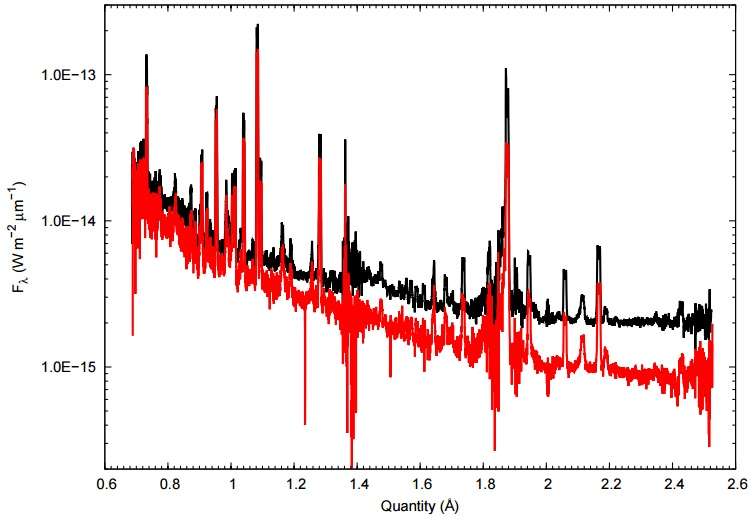IR spectra of V339 Del obtained at the IRTF; black spectrum obtained on 2015 Jun 28.46 (day 683.06), red spectrum on 2015 Dec 1.21 (day 839.30). Credit: Evans et al., 2016.
(Phys.org)—A team of astronomers led by Aneurin Evans of the Keele University, U.K., has observed the classical nova V339 Delphini (V339 Del for short) and spotted some peculiar changes in its dust shell. These observations could improve our knowledge about dust formation around stellar remnants. The results of the observational campaign are presented in a paper published Dec. 19 on the arXiv pre-print repository.
Discovered in August 2013, V339 Delphini is a bright nova in the constellation Delphinus. It is the first nova that has been observed to synthesize lithium, providing the first direct evidence of the supply of lithium to the interstellar medium by an astronomical object. Interestingly, follow-up observations after the discovery of V339 Delphini showed that one month after its detection, dust formation commenced in this nova.
To better understand the dust formation process in V339 Delphini, Evans and his colleagues have analyzed sets of data provided by the Stratospheric Observatory For Infrared Astronomy (SOFIA), the Mt. Abu Infrared Observatory in India, the O'Brien Observatory in Marine on St Croix, Minnesota, NASA's Infrared Telescope Facility (IRTF), Hawaii, and the Multiple Mirror Telescope (MMT), located on Mt. Hopkins, Arizona.
The data collected from over two years of observations allowed the researchers to distinguish an apparent rise and decline of the mass and radius of dust grains around this stellar remnant.
The team noted that the rapid dust formation occurs around 34th day of observations and afterward, the infrared emission became dominated by the dust. They also found that the dust is graphitic and its condensation temperature was 1,480 K at that moment.
According to the paper, the dust shell that formed had a mass of about five billionths of the mass of the sun and the grains grew to a dimension of a few micrometers. Next, the size and mass of the grains increased rapidly (while the temperature dropped to about 1,000 K), peaked around 100 days after eruption, and finally declined precipitously after this peak.
"The mass of dust initially rose as a result of an increase in grain size and/or number, peaked at about day 100, and then declined precipitously," the paper reads.
The researchers sought the most plausible explanation for the observed rise and fall of V339 Delphini's dust shell. According to them, this change is most likely caused by charging of dust grains by the X-ray emission.
"We attribute this to the charging of dust grains by the X-ray emission of V339 Del, causing the grains to shatter due to electrostatic stress," the astronomers concluded.
Moreover, the authors of the paper excluded the possibility that the destruction of dust grains could be due to evaporation as the temperature was too low to evaporate these graphitic grains.
"When the dust mass peaked around day 100, the dust temperature was about 1,000 K and steadily declined thereafter; it seems unlikely, therefore, that below 1,000 K, graphitic grains—for which the sublimation temperature is more than 1,800 K for carbon-rich environments— would be subject to evaporation," the scientists wrote in the paper.
More information: Rise and fall of the dust shell of the classical nova V339 Delphini, arXiv:1612.06241 [astro-ph.SR] arxiv.org/abs/1612.06241
Abstract
We present infrared spectroscopy of the classical nova V339 Delphini, obtained over a ∼2 year period. The infrared emission lines were initially symmetrical, with HWHM velocities of 525 km s−1. In later (t≳77days, where t is the time from outburst) spectra however, the lines displayed a distinct asymmetry, with a much stronger blue wing, possibly due to obscuration of the receding component by dust. Dust formation commenced at ∼ day 34.75 at a condensation temperature of 1480±20K, consistent with graphitic carbon. Thereafter the dust temperature declined with time as Td∝t−0.346, also consistent with graphitic carbon. The mass of dust initally rose, as a result of an increase in grain size and/or number, peaked at ∼ day 100, and then declined precipitously. This decline was most likely caused by grain shattering due to electrostatic stress after the dust was exposed to X-radiation. An Appendix summarises Planck Means for carbon, and the determination of grain mass and radius for a carbon dust shell.
© 2016 Phys.org
























